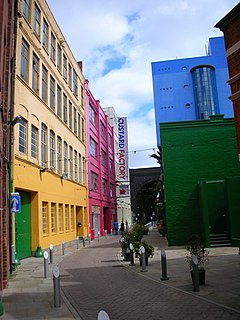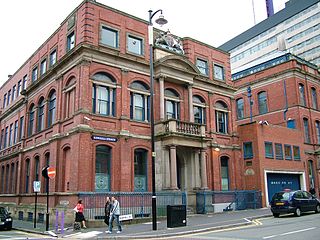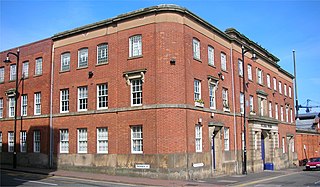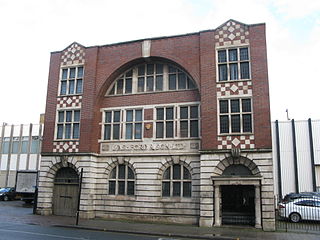
A fountain pen is a writing instrument which uses a metal nib to apply a water-based ink to paper. It is distinguished from earlier dip pens by using an internal reservoir to hold ink, eliminating the need to repeatedly dip the pen in an inkwell during use. The pen draws ink from the reservoir through a feed to the nib and deposits the ink on paper via a combination of gravity and capillary action. Filling the reservoir with ink may be achieved manually, via the use of an eyedropper or syringe, or via an internal filling mechanism which creates suction or a vacuum to transfer ink directly through the nib into the reservoir. Some pens employ removable reservoirs in the form of pre-filled ink cartridges.

A dip pen or nib pen or pen nib usually consists of a metal nib with capillary channels like those of fountain pen nibs, mounted in a handle or holder, often made of wood. Other materials can be used for the holder, including bone, metal and plastic; some pens are made entirely of glass.

The Custard Factory is a creative and digital business workspace complex, including independent shops, cafes and bars, on the site of what was the Bird's Custard factory off High Street, Deritend, in the Digbeth area of central Birmingham, England.

Hockley is a central inner-city district in the city of Birmingham, England. It lies about one mile north-west of the city centre, and is served by the Jewellery Quarter station. Birmingham's Jewellery Quarter continues to thrive in Hockley, and much of the original architecture and small artisan workshops have survived intact.

The Jewellery Quarter is an area of central Birmingham, UK, in the north-western area of Birmingham City Centre, with a population of around 19,000 people in a 1.07-square-kilometre (264-acre) area.
The Birmingham pen trade evolved in the Birmingham Jewellery Quarter and its surrounding area in the 19th century; for many years, the city was the centre of the world's pen trade, with most dip pens being produced there. At the height of the Jewellery Quarter's operations, there were about 100 pen factories, which employed around 8,000 skilled craftspeople.

The Birmingham Assay Office, one of the four assay offices in the United Kingdom, is located in the Jewellery Quarter, Birmingham. The development of a silver industry in 18th century Birmingham was hampered by the legal requirement that items of solid silver be assayed, and the nearest Assay Offices were in Chester and London. Matthew Boulton and Birmingham's other great industrialists joined forces with silversmiths of Sheffield to petition Parliament for the establishment of Assay Offices in their respective cities. In spite of determined opposition by London silversmiths, an Act of Parliament was passed in March 1773, just one month after the original petition was presented to Parliament, to allow Birmingham and Sheffield the right to assay silver. The Birmingham Assay Office opened on 31 August 1773 and initially operated from three rooms in the King's Head Inn on New Street employing only four staff and was only operating on a Tuesday. The first customer on that day was Matthew Boulton.

St Paul's Square is a Georgian square in the Jewellery Quarter, Birmingham, England, named after the church in its centre. It is the last remaining Georgian Square in the city.

The Argent Centre is a Grade II* listed building on the corner of Frederick Street and Legge Road in the Jewellery Quarter of Birmingham, England.

1–7 Constitution Hill in Birmingham, England is a Grade II listed building at the acute junction with Hampton Street, and is a former H.B. Sale factory. The red brick and terracotta structure is extremely thin, with a tower at one end.

The Museum of the Jewellery Quarter is a museum at 75-79 Vyse Street in Hockley, Birmingham, England. It is one of the nine museums run by the Birmingham Museums Trust, the largest independent museums trust in the United Kingdom.

The Elkington Silver Electroplating Works was a building on Newhall Street in Birmingham, England. It later housed the Birmingham science museum Museum of Science and Industry until the creation of Thinktank.

A nib is the part of a quill, dip pen, fountain pen, ball point or stylus which comes into contact with the writing surface in order to deposit ink. Different types of nibs vary in their purpose, shape and size, as well as the material from which they are made.

Birmingham City Centre, also known as Central Birmingham and often known locally as town, is the central business district of Birmingham, England. Following the removal of the Inner Ring Road, the city centre is now defined as being the area within the Middle Ring Road. The city centre is undergoing massive redevelopment with the Big City Plan, which means there are now nine emerging districts and the city centre is approximately five times bigger.

Newman Brothers at The Coffin Works is a museum in the Newman Brothers Coffin Furniture Factory building in the Jewellery Quarter conservation area in Birmingham, England. The museum educates visitors about the social and industrial history of the site, which operated from 1894–1998 as a coffin furniture factory. The museum opened in October 2014 after a fifteen-year campaign by the Birmingham Conservation Trust to save the factory building, which ceased trading in 1998, and raise the funds to transform it into a heritage attraction. Located at 13–15 Fleet Street, the building is Grade II* listed.
Smith and Pepper was a jewellery manufacturing firm in Birmingham, England, which traded between 1899 and 1981. The factory is now the Museum of the Jewellery Quarter.

The Victoria Works is a Grade II listed building in the Jewellery Quarter of Birmingham, England. It was built in 1839–40 for Joseph Gillott, who manufactured pen nibs, and was one of the first purpose-built factories in the Jewellery Quarter. It is situated opposite the Argent Centre, another building constructed for industrial use around the same period. The factory was one of the largest of its kind, with nearly 600 workers. Steam engines of 60 horsepower powered the mass production of the nibs.
Joseph Gillott's was an English manufacturing company based in Birmingham founded by Joseph Gillott in 1827 that produced high-quality dip pens. In 1961, Joseph Gillott's was taken over by British Pens Ltd., becoming a brand of it. Pen lines with the Gillott's name were manufactured in the British Pens factory of West Midlands, and currently commercialised by William Mitchell Ltd, one of the brands of the corporation.

Birmingham, Its people, Its History is a permanent exhibition at Birmingham Museum and Art Gallery and is also unofficially known as the Birmingham History Galleries. It opened to the public in October 2012 and is located on the third floor of the museum covering an area of 1,040 square metres. The exhibition is divided into five galleries which explore the story of Birmingham, England, and its people over a period of 900 years, from the 12th century to the present day. Over 1,500 objects are displayed from the museum’s designated collections, many of which can be seen on the museum's Flickr account. The £8.9m capital development was principally funded by the Heritage Lottery Fund, but other funders also include Arts Council England, The Wolfson Foundation and Birmingham City Council. The galleries were designed by Redman Design of Ilkley, Yorkshire, in collaboration with the curatorial department at Birmingham Museum and Art Gallery.

The former Ashford & Sons factory in Birmingham, England is a Grade II* listed building in Arts & Crafts style.




















